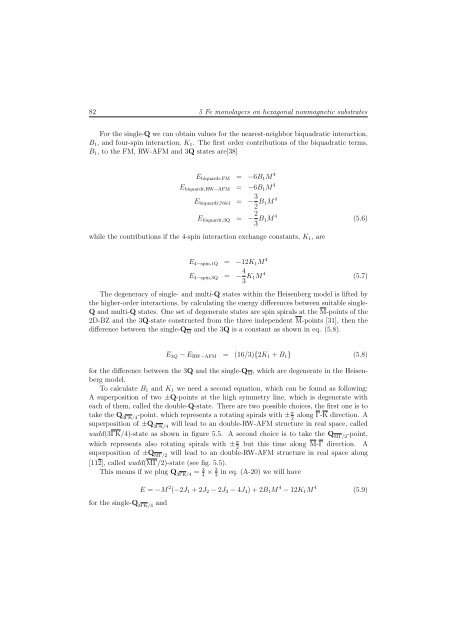Ab initio investigations of magnetic properties of ultrathin transition ...
Ab initio investigations of magnetic properties of ultrathin transition ...
Ab initio investigations of magnetic properties of ultrathin transition ...
Create successful ePaper yourself
Turn your PDF publications into a flip-book with our unique Google optimized e-Paper software.
82 5 Fe monolayers on hexagonal non<strong>magnetic</strong> substrates<br />
For the single-Q we can obtain values for the nearest-neighbor biquadratic interaction,<br />
B1, and four-spin interaction, K1. The first order contributions <strong>of</strong> the biquadratic terms,<br />
B1, to the FM, RW-AFM and 3Q states are[38]<br />
Ebiquardr,FM = −6B1M 4<br />
Ebiquardr,RW−AFM = −6B1M 4<br />
Ebiquardr,Néel = − 3<br />
Ebiquardr,3Q =<br />
4<br />
B1M<br />
2<br />
− 2 4<br />
B1M<br />
3<br />
while the contributions if the 4-spin interaction exchange constants, K1, are<br />
E4−spin,1Q = −12K1M 4<br />
(5.6)<br />
E4−spin,3Q = − 4 4<br />
K1M (5.7)<br />
3<br />
The degeneracy <strong>of</strong> single- and multi-Q states within the Heisenberg model is lifted by<br />
the higher-order interactions, by calculating the energy differences between suitable single-<br />
Q and multi-Q states. One set <strong>of</strong> degenerate states are spin spirals at the M-points <strong>of</strong> the<br />
2D-BZ and the 3Q-state constructed from the three independent M-points [31], then the<br />
difference between the single-QM and the 3Q is a constant as shown in eq. (5.8).<br />
E3Q − ERW−AFM = (16/3){2K1 + B1} (5.8)<br />
for the difference between the 3Q and the single-QM , which are degenerate in the Heisenberg<br />
model.<br />
To calculate B1 and K1 we need a second equation, which can be found as following:<br />
A superposition <strong>of</strong> two ±Q-points at the high symmetry line, which is degenerate with<br />
each <strong>of</strong> them, called the double-Q-state. There are two possible choices, the first one is to<br />
take the Q3ΓK/4-point, which represents a rotating spirals with ± π along Γ-K direction. A<br />
2<br />
superposition <strong>of</strong> ±Q3ΓK/4 will lead to an double-RW-AFM structure in real space, called<br />
uudd(3ΓK/4)-state as shown in figure 5.5. A second choice is to take the QMΓ/2-point, which represents also rotating spirals with ± π but this time along M-Γ direction. A<br />
2<br />
superposition <strong>of</strong> ±QMΓ/2 will lead to an double-RW-AFM structure in real space along<br />
[112], called uudd(MΓ/2)-state (see fig. 5.5).<br />
in eq. (A-20) we will have<br />
This means if we plug Q 3ΓK/4 = 3<br />
4<br />
for the single-Q 3ΓK/4 and<br />
× 2<br />
3<br />
E = −M 2 (−2J1 +2J2 − 2J3 − 4J4)+2B1M 4 − 12K1M 4<br />
(5.9)

















